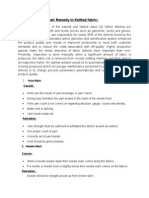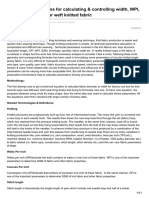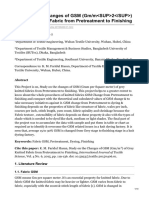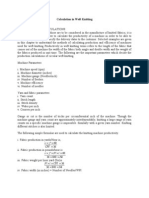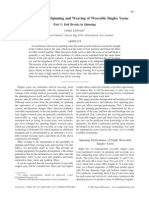33%(3)33% found this document useful (3 votes)
3K viewsCircular Knitted Fabrics
Circular Knitted Fabrics
Uploaded by
rdsekar76the presentation is about how to construct a fabric with good feel and to acheieve correct weight, width and Feelings.
Copyright:
Attribution Non-Commercial (BY-NC)
Available Formats
Download as PPS, PDF, TXT or read online from Scribd
Circular Knitted Fabrics
Circular Knitted Fabrics
Uploaded by
rdsekar7633%(3)33% found this document useful (3 votes)
3K views16 pagesthe presentation is about how to construct a fabric with good feel and to acheieve correct weight, width and Feelings.
Copyright
© Attribution Non-Commercial (BY-NC)
Available Formats
PPS, PDF, TXT or read online from Scribd
Share this document
Did you find this document useful?
Is this content inappropriate?
the presentation is about how to construct a fabric with good feel and to acheieve correct weight, width and Feelings.
Copyright:
Attribution Non-Commercial (BY-NC)
Available Formats
Download as PPS, PDF, TXT or read online from Scribd
Download as pps, pdf, or txt
33%(3)33% found this document useful (3 votes)
3K views16 pagesCircular Knitted Fabrics
Circular Knitted Fabrics
Uploaded by
rdsekar76the presentation is about how to construct a fabric with good feel and to acheieve correct weight, width and Feelings.
Copyright:
Attribution Non-Commercial (BY-NC)
Available Formats
Download as PPS, PDF, TXT or read online from Scribd
Download as pps, pdf, or txt
You are on page 1of 16
At a glance
Powered by AI
The presentation discusses different types of fabrics including woven and knitted fabrics. It focuses on circular knitted fabrics, their parameters and construction methods.
The main types of fabrics discussed are woven fabrics and knitted fabrics. Woven fabrics are made using a warp and weft, while knitted fabrics are made through loop formation. Some common knitted fabric varieties mentioned are jersey, rib, interlock, pique and fleece.
The main parameters considered for knitted fabrics are GSM, width, and shrinkage. Any deviation from these can lead to heavy losses. The major fabric structures discussed are single jersey, rib, and interlock, which account for 90% of knitted fabrics.
CIRCULAR KNITTED FABRICS
@ TEA-ERC 27-10-2009
Presentation by
CBC Fashions Asia Pvt Ltd.,
Tirupur – India
Any Errors in the
presentation write to
info@cbc.co.in
Types of Fabrics
Woven Fabrics Knitted Fabrics
- Warp/Weft - Loop formation
- Varieties are Poplin, - Varieties are Jersey,
Corduroy, Flannel, RIB, Interlock,
Denim, Drill, etc., Pique, Fleece, etc.,
- Looms - Knitting machines
- Flat Knit
- Circular Knit
Knitted Fabrics
Major Fabric Main Parameters
Structures • GSM
• Single Jersey • Width
• RIB
• Shrinkage
• Interlock
Any deviation in the
All our knitted fabrics
are 90% based on above parameters
these 3 Kinds only lead to heavy loss
Construction of
Circular Knitted Fabrics
• Our conventional method of fabric construction
is basically Trial and Error Method which is
time and cost consuming
• Using Starfish Predictions from Cotton
Technology International we can construct our
fabrics based on calculations
• Main aspect for fabric construction is the Fabric
Feeling or Tightness Factor (TF)
Fabrics Based on Feeling
• Tight Fabric – Problems – Streks, Needle Holes,
Holes, Colour shading, Slubs etc
• Loose Fabric – Problems – See thru, Shrinkage,
Spirality, Unstable, Deform etc
• Normal Fabric – Good, optimum performance,
proper fit, retains shape, stable, clean and
smooth surface etc.,
Tightness Factor
• How to differentiate the Tight fabric,
Loose Fabric and Normal fabric?
• Tightness Factor is the proper
measuring tool for the fabric feeling.
• TF = √Tex Count ÷ LL in cms for 1 loop
• Tex Count = 590.46/Ne Count
• Ex. Tex Count = 590.46/30’s = 19.682
• Ex. TF = √19.682 ÷ .29 = 15.29
TF value for Regular Fabrics
S.Jersey Rib 1 x 1Interlock2T Fleece
Normal 15.5 15.5 12.5 15 Face /
1.5 Loop
Innerwear 14.5 14.5 12.0
TF is inversely proportional to LL and so
Outerwea 16.5 16.5 13.5
if LL is more then TF=14 is Less which means the fabric is
rmore loose if LL is less then TF=18 is more which means the
fabric is more tight
Using Star Fish Predictions
• Based on the TF we need to construct our fabrics using
the Star Fish predictions
• Width GSM and Shrinkage is affected mainly due to Yarn
Count and LL.
• Diameter, Gauge, RPM, No of Needles, Feeders per Inch
are not much important factor for cost saving.
• If you exactly know Finishing GSM, Finishing Dia, Finishing
Shrinkage, Exact Yarn Count, Machine Gauge and
Machine Limitations, then the star fish predictions can
help you select the knitting Dia.
• Gauge is selected based on the yarn count selected
Tex Count From Yarn
• Lea Method – Need Length in yards
and Weight in grams
• Count = 64.8/Lea Weight in grams
• 1 Lea = 120 yards
• 80 rotations in Wrap Reel = 120 yard
• 1 rotation in wrap reel = 1.5 yards
• 7 lea = 1 hanks = 840 yards
Tex Count From Fabric
• Tex Count = (Yarn Length in Inches ÷ Weight
in grams ) x 0.015
Or
• Tex Count = ( Yarn Length in cms ÷ Weight in
grams) x 0.0059
• Find out the LL from fabric is unraveling
• Then do find yarn count from the above
• Construct your fabrics
• No of 840 yards in 1 pound = Count
• 1 pound = 454 grams
• 1 yard = 0.914 mtrs
• 120 yards = 1 Lea
• 7 Leas = 7 x 120 yds = 840 yds = 1 hanks
• 454gms ÷ 7 Lea = 64.8 gms for 1 lea of 1’s
• 840 yds = 1 hanks = 1 pound or 454 gms
• 1 pound = 1 x 840 yds = 840 yds = 1’s
• 1 pound = 2 x 840 yds = 1680 yds = 2’s
• 1 pound = 10 x 840 yds = 8400 yds = 10’s
• 1 pound = 20 x 840 yds = 16800 yds = 20’s
Single Jersey 150 gsm 30’s count 24gg
Knitting Quality Sample 1 Sample 2 Sample 3
Yarn Count, Ne30 28.5 28.5
Stitch Length mm2.68 2.84 2.852
Course Length in cm604.6 640.7 643.4
Tightness Factor Cgs16.56 16.03 15.96
Finishing
Course/cm20.08 18.88
Wales/CM14.97 14.27
Weight g/sq.mtr150.7 150.6 150.1
Width cm29.64 31.1 36
Yield m/Kg4.4 4.2
Length Shrinkage5 5 5
Width Shirnkage5 5 5
The star fish predictions are available
for
- Single Jersey
- 1 x 1 Rib
- 2 x 2 Rib
- Interlock
- 2t Fleece
- 2 Tuck Pique
- 1 Tuck Pique
Benetton 8110 2 x 2 Rib Live Example
• 2 x 2 Rib 220 gsm required
• Selected count 30’s so gauge 18
• LL = 27.5 cms for K.Dia = 26
• Actual count = 27.8Ne = Tex 21.23
• TF = 16.75
• Result GSM=240, width=16 Shrinkage = L -1% & W-5%
• LL can be raised to 29.5 to get lesser gsm with same count or try to get
exact count at 28.5 then the LL @ 28.5cms.
• Result awaited.
Quality Customer Service
• By doing the fabric construction in the
scientific way we can construct a good fabric,
with exact requirements regarding the gsm,
width and shrinkage, by this way we can save
a lot of time and money, which is ultimately
resulting in the customer satisfaction.
• Construct your fabric and take 1 mtr of fabric
and do 3 times washing and 3 times tumble
dry and review the resultant GSM and
Resultant Dia. Shrinkage is Nil.
More Information Contact
• Mr.Balakrishnan, Bala’s School of Knitting
• Fabric consultant - Tirupur
• +919443132940
• balas@realknit.com
• Take Experts Advice and Save Money
You might also like
- 7.1. Count:: Weaving Calculation & Useful FormulasDocument12 pages7.1. Count:: Weaving Calculation & Useful FormulaskreeshnuNo ratings yet
- How Do You Calculate The Fabric Consumption For Knit GarmentsDocument3 pagesHow Do You Calculate The Fabric Consumption For Knit GarmentsimmmranNo ratings yet
- Assignment On Different Kinds of Knitting Faults Causes and Their RemediesDocument4 pagesAssignment On Different Kinds of Knitting Faults Causes and Their RemediesRaihan Moner Manush0% (2)
- Study On Fleece Knit FabricDocument45 pagesStudy On Fleece Knit Fabrickhurshid100% (1)
- Single Jersey FabricDocument4 pagesSingle Jersey FabricMrcr Kapzap0% (1)
- Merchandising Course.1Document17 pagesMerchandising Course.1Monir AhmmedNo ratings yet
- Carr and Latham's Technology of Clothing ManufactureFrom EverandCarr and Latham's Technology of Clothing ManufactureDavid J. TylerRating: 4 out of 5 stars4/5 (1)
- Types of Cotton Yarn and CountDocument8 pagesTypes of Cotton Yarn and CountMohammed Atiqul Hoque ChowdhuryNo ratings yet
- Knitting Calculation WDocument7 pagesKnitting Calculation Wnavin19895230100% (4)
- Project On Knitted Fabric ParametreDocument58 pagesProject On Knitted Fabric ParametreMozzammal Hossain Shaown100% (3)
- Change of Fabric GSM With Yarn CountDocument21 pagesChange of Fabric GSM With Yarn CountOptimisticPerson100% (2)
- Knitted Fabric Analysis CalculationDocument5 pagesKnitted Fabric Analysis Calculationmbstutextile75% (4)
- Process Flow Chart of Knitting: A. Stitch LengthDocument9 pagesProcess Flow Chart of Knitting: A. Stitch LengthAushru Hasan100% (1)
- Knitting CalculationsDocument11 pagesKnitting CalculationsArul Deepak50% (2)
- Knitting Production and Quality ControlDocument10 pagesKnitting Production and Quality ControlDr Muhammad Mushtaq Mangat50% (2)
- Fabric Consumption For Knit Garments Knit Fabric Consumptio CalculationDocument2 pagesFabric Consumption For Knit Garments Knit Fabric Consumptio CalculationFaisal Ibn Haque100% (3)
- Fully FashionDocument30 pagesFully FashiondewNo ratings yet
- How Do Calculate The Fabric & Yarn Consumption of A Yarn Dyed T-Shirt?Document9 pagesHow Do Calculate The Fabric & Yarn Consumption of A Yarn Dyed T-Shirt?light lightNo ratings yet
- Textile CalculationDocument6 pagesTextile CalculationKhandaker Sakib Farhad0% (1)
- Fiber Fineness, Yarn Counts and ConversionsDocument11 pagesFiber Fineness, Yarn Counts and ConversionsBhaskar LoganathanNo ratings yet
- KnittingDocument15 pagesKnittingReyad Billah100% (1)
- Knitting GSM CalculationsDocument11 pagesKnitting GSM CalculationsQasim Abbas Bhatti100% (2)
- Knitting CalculationDocument2 pagesKnitting Calculationmontasirahmed100% (1)
- Thread ConsumptionDocument4 pagesThread ConsumptionMd Mamun Hosain100% (1)
- How To Find Yarn Count From GSM - Textile Learner PDFDocument1 pageHow To Find Yarn Count From GSM - Textile Learner PDFKM NAZRUL Islam0% (1)
- Fabric Inspection GuidelinesDocument18 pagesFabric Inspection GuidelinesMohammed Atiqul Hoque Chowdhury100% (2)
- Efficiency Losses Calculation and Identify Causes of Losses of Circular Knitting Machine During Knit Fabric ProductionDocument4 pagesEfficiency Losses Calculation and Identify Causes of Losses of Circular Knitting Machine During Knit Fabric ProductionElias Khalil100% (1)
- Apparel Costing Unit - II NDocument49 pagesApparel Costing Unit - II NAnonymous BstqCP5aNo ratings yet
- Knitting Technology QUESTIONSDocument4 pagesKnitting Technology QUESTIONSkbalabala100% (1)
- Introduction To Knitting TechnologyDocument14 pagesIntroduction To Knitting TechnologyPushkar AwasthiNo ratings yet
- Textile Calculations and EquationsDocument1 pageTextile Calculations and Equationsarsh thakurNo ratings yet
- Tightness FactorDocument2 pagesTightness FactorAbi NikilNo ratings yet
- Calculate Nominal Production of A Fleece-Knitting Machine Per HourDocument3 pagesCalculate Nominal Production of A Fleece-Knitting Machine Per Hourkhurshid100% (1)
- Pilling of TextilesDocument16 pagesPilling of TextilesAthirah Mansor100% (3)
- ..Knitting Defects and Remedies..: Made By: Raisa GuptaDocument39 pages..Knitting Defects and Remedies..: Made By: Raisa Guptalovelife_gupta83% (6)
- Study On The Changes of GSM (GM/M 2) of Grey Knitted Fabric From Pretreatment To FinishingDocument19 pagesStudy On The Changes of GSM (GM/M 2) of Grey Knitted Fabric From Pretreatment To FinishingSamir RanaNo ratings yet
- Knitting 3Document6 pagesKnitting 3Sanaullah MuradNo ratings yet
- Analysis of Fancy Weave (Huckaback, Mock Leno, Honeycomb)Document10 pagesAnalysis of Fancy Weave (Huckaback, Mock Leno, Honeycomb)Shahadat Hossain75% (4)
- Yarn AssignmentDocument10 pagesYarn AssignmentHIMASHA SAMARANAYAKA100% (2)
- Presentation ShrinkageDocument27 pagesPresentation Shrinkagemhrscribd014No ratings yet
- Fabric Inspection SystemDocument18 pagesFabric Inspection Systemইসলামিক টিভিNo ratings yet
- Formula For Fabric Weight CalcualtionDocument2 pagesFormula For Fabric Weight Calcualtionmichahkg100% (1)
- Woven Fabric Consumption FormulaDocument2 pagesWoven Fabric Consumption FormulaShaaban Noaman100% (1)
- Air Jet Weaving: Control of Weft Breakages For Cotton & Polyester Weft YarnDocument7 pagesAir Jet Weaving: Control of Weft Breakages For Cotton & Polyester Weft YarnAdarsha PradhanNo ratings yet
- Some Important Weaving CalculationsDocument6 pagesSome Important Weaving CalculationsSiva KumartNo ratings yet
- Relation Betwwen Yarn Count and Fabric GSM and About Accessories and Trimmings of BangladeshDocument32 pagesRelation Betwwen Yarn Count and Fabric GSM and About Accessories and Trimmings of BangladeshAkanda Rasel100% (10)
- Knitting Calculation W PDFDocument7 pagesKnitting Calculation W PDFMuhammad Ilyas100% (1)
- How To Calculate Fabric Consumption For Woven BottomDocument6 pagesHow To Calculate Fabric Consumption For Woven BottomHazelle CarmeloNo ratings yet
- Some Important Weaving CalculationsDocument3 pagesSome Important Weaving CalculationsRagavendhiran ChandrasekaranNo ratings yet
- Study On Knitting MachineriesDocument52 pagesStudy On Knitting MachineriesAhmad ButtNo ratings yet
- Importance of Fabric Consumption CalculationDocument8 pagesImportance of Fabric Consumption Calculationudi96950% (2)
- Calculation in Weft KnittingDocument13 pagesCalculation in Weft KnittingFazley BD80% (10)
- Sadia Alam, Lecturer (FDT), Chittagong BGMEA Institute of Fashion & TechnologyDocument23 pagesSadia Alam, Lecturer (FDT), Chittagong BGMEA Institute of Fashion & TechnologyJubayer Uddin100% (1)
- Research & Development in TextileDocument40 pagesResearch & Development in Textileapi-19978170100% (2)
- Project On Knitted Fabric ParametreDocument47 pagesProject On Knitted Fabric Parametresaifsabid82% (22)
- Chapter-6-Garments CostingDocument69 pagesChapter-6-Garments CostingikumarpramanikNo ratings yet
- 4.knit Fabric Specification Consumption Yarn Consumption PDFDocument56 pages4.knit Fabric Specification Consumption Yarn Consumption PDFRifatNo ratings yet
- CalculationsDocument12 pagesCalculationsVinay GuptaNo ratings yet
- Research PaperDocument5 pagesResearch PaperOther stateNo ratings yet
- SSP: Artificial Grass Specification SheetDocument1 pageSSP: Artificial Grass Specification SheetYusef CevaNo ratings yet
- 21 Composite Materials PDFDocument43 pages21 Composite Materials PDFAngel Mine AlcantaraNo ratings yet
- Kniting Testing ChargesDocument2 pagesKniting Testing ChargesRanjith KumarNo ratings yet
- DBL 5943Document14 pagesDBL 5943Marko SamardžićNo ratings yet
- Lab Report: BGMEA University of Fashion and TechnologyDocument6 pagesLab Report: BGMEA University of Fashion and TechnologyRian HossainNo ratings yet
- Gate 2007Document9 pagesGate 2007sandeep100% (1)
- Quality On Yarn 1Document39 pagesQuality On Yarn 1Ashiq Khan100% (1)
- I73551 Tech Pack Giant TigerDocument15 pagesI73551 Tech Pack Giant Tigerripon.mstbt2023No ratings yet
- Unit - IVDocument15 pagesUnit - IVJoseph KuruvilaNo ratings yet
- Conversions - From Fabric HandbookDocument3 pagesConversions - From Fabric Handbooksukrit10No ratings yet
- Investigation of The Effects of Hollow Yarn Structure and WovenDocument15 pagesInvestigation of The Effects of Hollow Yarn Structure and Wovenmohammadi.m1324No ratings yet
- FormulaDocument6 pagesFormulapeeyush40No ratings yet
- Estimation of Quench Air Quantity For A Given Throughput in PET Melt SpinningDocument10 pagesEstimation of Quench Air Quantity For A Given Throughput in PET Melt SpinningAngel LagrañaNo ratings yet
- Design of Composite MaterialsDocument174 pagesDesign of Composite MaterialsyigitilgazNo ratings yet
- DL Texturing OBA DTY enDocument28 pagesDL Texturing OBA DTY enJuan Francisco Rubio JovelNo ratings yet
- SelvedgeDocument16 pagesSelvedgejony_nsu022No ratings yet
- Textile Spinning: Process Quality ControlDocument30 pagesTextile Spinning: Process Quality Controlaqsa imranNo ratings yet
- 521 - Open - D - Ujevic - ISITD PosterhezDocument9 pages521 - Open - D - Ujevic - ISITD PosterhezhaddanNo ratings yet
- Sitra Janfeb2015newsDocument22 pagesSitra Janfeb2015newsVenkat PrasannaNo ratings yet
- Textile InternshipDocument42 pagesTextile InternshipNutukurthi Venkat RamjiNo ratings yet
- Blast Leg IEDDocument16 pagesBlast Leg IEDHemant ChouhanNo ratings yet
- Twill Weave 165001-08 2 PDFDocument19 pagesTwill Weave 165001-08 2 PDFNadim MahmudNo ratings yet
- End Breaks in The Spinning and Weaving of Weavable Singles YarnsDocument5 pagesEnd Breaks in The Spinning and Weaving of Weavable Singles Yarnsapi-3733260No ratings yet
- Yarn EvennessDocument7 pagesYarn Evennesssubhaxyz9365No ratings yet
- Effect of Yarn CountDocument12 pagesEffect of Yarn CountSyed Salahuddin MunnaNo ratings yet
- Ghada Ali Abou-NassifDocument10 pagesGhada Ali Abou-NassifhawNo ratings yet
- Data WarehousdeDocument123 pagesData WarehousdeShivjeet SinghNo ratings yet
- User Manual DigiBunai PDFDocument53 pagesUser Manual DigiBunai PDFDinesh Bhathela100% (1)


